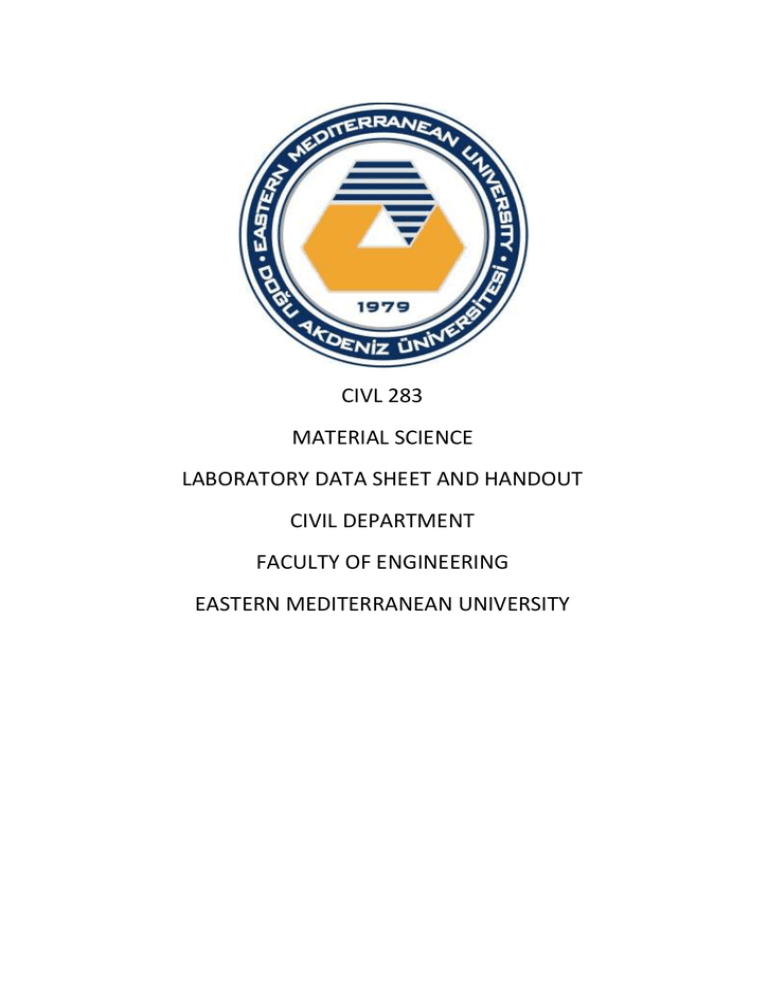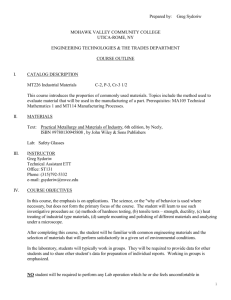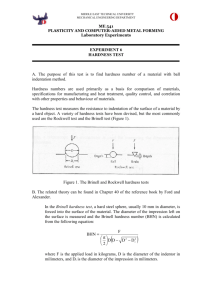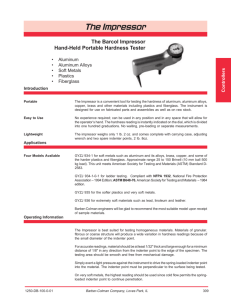tensile test - Ekrem iZMiR
advertisement

CIVL 283 MATERIAL SCIENCE LABORATORY DATA SHEET AND HANDOUT CIVIL DEPARTMENT FACULTY OF ENGINEERING EASTERN MEDITERRANEAN UNIVERSITY TENSILE TEST 1) OBJECTIVE To measure and observe the behaviour of a tensile specimen, while being tested to destruction, and determine: (a) (b) (c) (d) (e) The yield stress of the material. The ultimate stress of the material. The percentage elongation. The percentage reduction in area. The value of modulus elasticity and poisons ratio of the material. 2) Preliminary Remarks Write only on paragraph from ASTM E8 3) APPARATUS 1) Tensometer,2) Elongation gauge, 3)Reduction in area gauge, 4) callipers, tensile specimens. 4) PROCEDURE (Write Your own Procedure don’t copy paste it) 3 5) Calculation Procedure for calculation 1) Prepare this table while performing the tensile test and fill the reading of gauges from the test. Table 1: Force Reading F (N) 0 1 … Elongation Li-Lo=ΔL (mm) 2) After you fill table 1 plot the Force versus Elongation. 3) From the equations find the values for the nominal and true stress, and nominal and true strain. Lo = ……….. mm, Ao = ……….. mm2 Table 2: Reading F (N) Ai ΔL σnom σtrue (mm2) (mm) N/mm2 N/mm2 εnom Li (mm) 0 1 … After you fill table 2 plot, a) Nominal stress versus Nominal Strain b) True stress versus True Strain 4) Finally, using the true stress versus true strain curve determine a) Yield strength (σy), b) Elasticity modulus (E), c) Ultimate stress (σu) and d) Fracture strain. e) percent elongation and percent reduction. Note: use this equations Nominal Stress: nom F Li F , True Stress*: true , Ao Ao Lo ( Ai Ao Lo ) Li εtrue Nominal Strain: εnom. = Li Lo Li , True Strain*: true ln Lo Lo *True stress and true strain are the corrected values due to specimen necking. Elasticity modulus (Young’s modulus): Yield stress: E= σγ = load at yield point Ao Ultimate stress: σu = ultimate load Ao Percent elongation = LF Lo 100%, (LF: Final length) Lo Percent area reduction Ao AF 100%, (AF: Final Area) Ao Discussion of Results: Discuss your results using ASTM E8 source and Standards for metals if available. 5. CONCLUSIONS Comment on each of the results obtained, how accurate they are, and how they compare to published values. What, if any, are the possible sources of error in your experiment? How important are these errors? HARDNESS TEST 1. OBJECTIVE Our primary aim is to measure the Rockwell Hardness values of materials and estimate ultimate tensile strengths by the aid of conversion tables. 2. HARDNESS TESTING THEORY Hardness is usually defined as the resistance of a material to plastic penetration of its surface. There are three main types of tests used to determine hardness: • Scratch tests are the simplest form of hardness tests. In this test, various materials are rated on their ability to scratch one another. Mohs hardness test is of this type. This test is used mainly in mineralogy. • In Dynamic Hardness tests, an object of standard mass and dimensions is bounced back from a surface after falling by its own weight. The height of the rebound is indicated. Shore hardness is measured by this method. • Static Indentation tests are based on the relation of indentation of the specimen by a penetrator under a given load. The relationship of total test force to the area or depth of indentation provides a measure of hardness. The Rockwell, Brinell, Knoop, Vickers, and ultrasonic hardness tests are of this type. For engineering purposes, mostly the static indentation tests are used. BRINELL HARDNESS TEST: This test consists of applying a constant load, usually between 500 and 3000 kgf for a specified time (10 to 30 s) using a 5 or 10-mm diameter hardened steel or tungsten carbide ball on the flat surface of a workpiece. Hardness is determined by taking the mean diameter of the indentation and calculating the Brinell hardness number (BHM or HB) by dividing the applied load by the surface area of the indentation according to following formula: where P is load in kg; D ball diameter in mm; and d is the diameter of the indentation in mm. Calculations have already been made and are available in tabular form for various combinations of diameters of impressions and load. The Brinell hardness number followed by the symbol HB without any suffix numbers denotes standard test conditions using a ball of 10 mm diameter and a load of 3,000 kg applied for 10 to 15 s. For other conditions, the hardness number and symbol HB are supplemented by numbers indicating the test conditions in the following order: diameter of ball, load, and duration of loading. For example, 75 HB 10/500/30 indicates a Brinell hardness of 75 measured with a ball of 10 mm diameter and a load of 500 kg applied for 30s. Lab Report: Objective: Write the objective only in one paragraph. (see ASTM A370) 1) Preliminary Remarks: One paragraph (see ASTM A370) 2) Apparatus: 1) Brinell hardness tester (fig.2) 2) Ball indenter. 3) Test specimen (write which specimen will be used in the test e.g.: aluminum, brass, steel……etc.) 4) Procedure. (Use your own procedure Don’t copy paste) 1.Load to be applied for hardness test should be selected according to the expected hardness of the material. However test load shall be kept equal to 30 times the square of the diameter of the ball (diameter in mm) F=30.D 2 .Where ball diameter, generally taken as 10 mm. For guidelines hardness range for standard l oads given below 2.Apply the load for a minimum of 15 seconds to 30 seconds. [if ferrous metals are to be tested time applied will be 15 seconds and for softer metal 30 seconds] 3.Remove the load and measure the diameter of indentation nearest to 0.02 mm using microsc ope (projected image) 4.Calculate Brinell hardness number (HB). As per IS: 1500. 5.Brinell hardness number where D is the diameter of ball indenter and d is the diameter of indentation. Hardness numbers normally obtained for different materials are given below (under 3000 kg and 10 mm diameter ball used) Note: Brinell test is not recommended for then materials having HB over 630. It is necessary to mention ball size and load with the hardness test when standard size of ball and load are not us ed. Because indentation done by different size of ball and load on different materials are not geometrically similar. Ball also undergoes deformation when load is applied. Material response to the load is not same all the time. 6.Brinell hardness numbers can be obtained from tables 1 to 5 given in IS: 1500, knowing diame ter of indentation, diameter of the ball and load applied. 5) Calculation 6) Result and Discussion of Results The Brinell hardness number of the specimen is ------Compare the Results with standards, and write what does this number of brinell hardness means. 7) Conclusion Comment on each of the results obtained, how accurate they are, and how they compare to published values. What, if any, are the possible sources of error in your experiment? How important are these errors? ROCKWELL HARDNESS TEST: This hardness test uses a direct reading instrument based on the principle of differential depth measurement. Rockwell testing differs from Brinell testing in that the Rockwell hardness number is based on an inverse relationship to the measurement of the additional depth to which an indenter is forced by a heavy (major) load beyond the depth resulting from a previously applied (minor) load. Initially a minor load is applied, and a zero datum position is established. The major load is then applied for a specified period and removed, leaving the minor load applied. The resulting Rockwell number represents the difference in depth from zero datum position as a result of the application of major load. The entire procedure requires only 5 to 10 s. Use of a minor load greatly increases the accuracy of this type of test, because it eliminates the effects of backlash in the measuring system and causes the indenter to break through slight surface roughness. In Rockwell testing, the minor load is 10 kgf, and the major load is 60, 100 or 150 kgf. In superficial Rockwell testing, the minor load is 3 kgf, and major loads are 15, 30 or 45 kgf. In both tests, the indenter may be either a diamond cone or steel ball, depending principally on the characteristics of the material being tested. 1. Depth of indentation under preliminary load (10 kg) 2. Increase in depth of indentation under additional load (140 kg) 3. Permanent increase of depth of indentation under preliminary load after removal of additional load, the increase being expressed in units of 0002 mm 4. Rockwell hardness HRC = 100—e There are 30 different Rockwell scales, defined by the combination of the indenter and minor and major loads. The suitable scale is determined due to the type of the material to be tested. The majority of applications are covered by the Rockwell C and B scales for testing steel, brass, and other materials. 1) Objective: Write the objective only in one paragraph. (see ASTM A370) 2) Preliminary Remarks: One paragraph (see ASTM A370) 3) Apparatus: Rockwell hardness testing machine. Black diamond cone indenter, 4) Test specimen (write which specimen will be used in the test e.g.: aluminum, brass, steel……etc.) 5) Procedure. (Use your own procedure Don’t copy paste) 1. Examine hardness testing machine (fig.1). 2. Place the specimen on platform of a machine. Using the elevating screw raise the platform and bring the specimen just in contact with the ball. apply an initial load until the small pointer shows red mark. 3. Release the operating valve to apply additional load. Immediately after the additional load applied, bring back operating valve to its position. 4. Read the position of the pointer on the C scale, which gives the hardness number. 5. Repeat the procedure five times on the specimen selecting different points for indentation. 5) Calculation: Hardness value based on the difference in depths of indentation produced by minor and major load. Diamond indenters are used mainly for testing materials such as hardened steels and cemented carbides. Steel-ball indenters, available with diameters of 1/16, 1/8, 1/4 and 1/2 in., are generally used for testing materials such as soft steel, copper alloys, aluminum alloys and bearings metals. Designations and typical applications of various indentors are listed in Tables 2 and 3. The minor load is always 10 kg in regular Rockwell hardness testing. No Rockwell hardness value isexpressed by a number alone. A letter has been assigned to each combination of load and indenter, as indicated in Tables 1 and 2. Each number is suffixed first by the letter H (for hardness), then the letter R (forRockwell), and finally the letter that indicates the scale used. For example, a value of 60 in the Rockwell C scale is expressed as 60 HRC, etc. One Rockwell number represents an indentation of 0.002 mm (0.00008in.). Therefore a reading of 60 HRC indicates an indentation from minor to major load of (100 - 60) X 0.002 mm =0.080 mm or 0.0032 in. A reading of 80 HRB indicates an indentation of (130 - 80) X 0.002 mm = 0.100 mm. The metal immediately surrounding the indentation from a Rockwell hardness test is cold worked thus multiplereadings cannot be taken at the same point on a material’s surface. If multiple tests are conducted on asingle part the indentations should each be a minimum of 3 indentation diameters apart. The depth of material affected during testing is on the order of ten times the depth of the indentations. Therefore, unless the thickness of the metal being tested is at least ten times the depth of the indentation,an accurate Rockwell hardness test cannot be expected. In addition to the limitation of indentation depth for a workpiece of given thickness and hardness, there is a limiting factor on the minimum material width. If the\ indentation is placed too close to the edge of a workpiece, the edge will deform outward and the Rockwell hardness number will be decreased accordingly. Experience has shown that the distance from the center of the indentation to the edge of the workpiece must be at least 3 times the diameter of the indentation to ensure an accurate test. 6) Result and Discussion of Result: Rockwell hardness of given specimen is --------Use the above tables and scales to comment on your results 7) Conclusion Comment on each of the results obtained, how accurate they are, and how they compare to published values. What, if any, are the possible sources of error in your experiment? How important are these errors?




